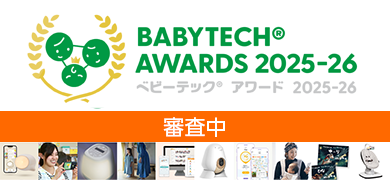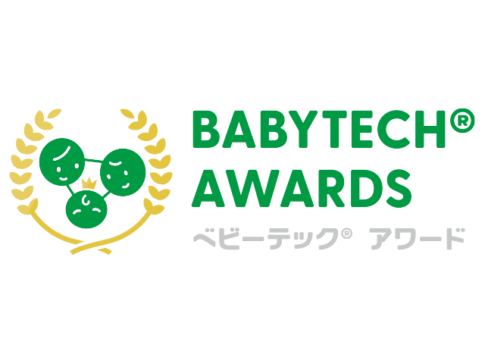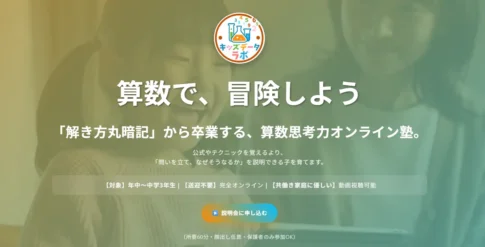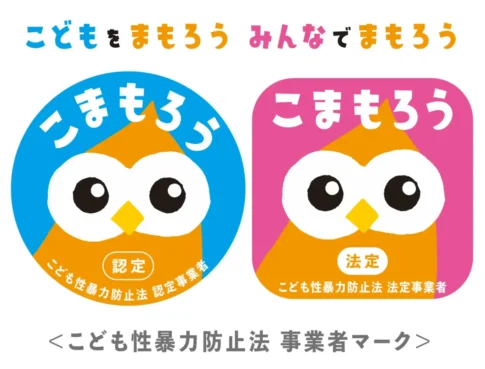- It greatly reduces the burden of "shift list creation," which used to take an average of 10 to 12 hours each month!
- Usability is also improved, with less "initial setup" and "rework" than similar conventional services!
- Streamlining the work of the director and head class, allowing them to focus on their primary management tasks!
Unifa Corporation, which has developed and sold a series of revolutionary childcare items such as "Lukumi Noon Sleep Check" and "Lukumi Thermometer," and also took over the business of "Kidsly," a preschool attendance management system that has spread throughout Japan, announced the release of a new service called "Lukumi Shift Management" in December 2019. The new service is called "Lukumi Shift Management. This will greatly reduce the burden of "creating and modifying shifts for childcare workers," which used to be very annoying for preschool directors and head classes and forced them to devote their valuable time to the task. The BabyTech.jp editorial staff interviewed Mr. Daigo Kobayashi of Unifa Corporation (honorifics omitted), the business manager of "Lukumi Shift Management," to get an overview of the service, how it was developed, and what the future holds.

Mr. Kobayashi, business manager of this service
(We spoke to...)
Unifa Corporation
Business Division HR Group
Manager, Solutions Section
Hirotake Kobayashi
Improve the nursery environment by reducing the workload of the "managerial class."
Editorial:Can you tell us why you developed the "Shift Management Creation" service for daycare centers?
Kobayashi:According to our survey, on average, nursery school teachers spend 10 to 12 hours each month creating and managing work shifts. Lukumi Shift Management streamlines the process of creating and managing work shifts. The work is mainly done by "managers" such as directors and supervisors, and we believe that "Lukumi Shift Management" will reduce their workload so that they can focus more on the childcare field and listen to the concerns of childcare teachers... ...and we believe that this is a good idea.
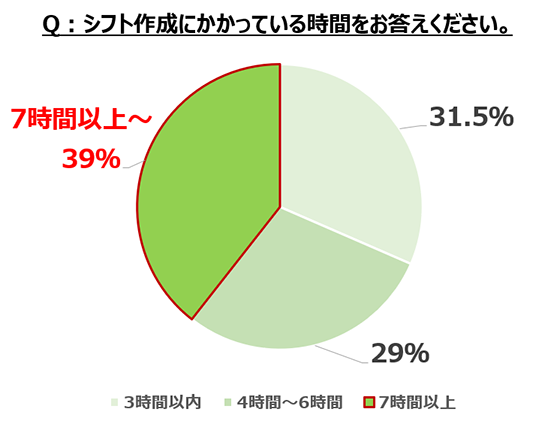
Survey results of time spent creating and managing work shifts
Editorial:In other words, they will be able to devote more time to "management work.
Kobayashi: Yes, it is. The field of childcare is not a workplace where one only needs to manage the progress of "specific operations (=tasks)" as in a general company; it is a job where one is responsible for watching over the growth of children. Therefore, I think it is very important to create an environment where daycare teachers can easily consult with managers in the course of their daily work.
Editorial:Perhaps it could also have the effect of reducing the turnover rate of childcare workers.
Kobayashi:This is my personal ideal as well, but behind the development of "Lukumi Shift Management" was my desire to "value children's dreams. When elementary and junior high school-aged children are asked what they want to be in the future, nursery school teacher is one of the top 10 most popular occupations for girls. In reality, however, there is a shortage of nursery school teachers, and it is said that there are as many as 800,000 potential nursery school teachers. I believe that the profession that children want to become in the future should not remain a hard and painful one, and for this reason, I focused on "shift management," which is a high-volume job, because I thought it was necessary to improve childcare workplaces and make operations more efficient.
There are still many "analog tasks" in the nursery that can be saved with IT
Editorial:Next, can you give us an overview of "Lukumi Shift Management"?
Kobayashi:There are three reasons why "creating and managing shifts at a daycare center" takes up so much of your time. The first one is the standard for the placement of nursery school teachers. The number of nursery teachers that must be assigned is determined according to the number of children attending the school, so shifts must be created to meet that number. Then, when creating the shift schedule, it is necessary to count the number of nursery teachers during the daycare hours. If this is the case at a daycare center where shifts are made on paper, you have to work while counting "how many people are in the daycare center at this time of the day: ......." That is exactly what you have to do. Some nurseries use the character for "correct" and count as they create the shift. Furthermore, it is often the case that in the middle of creating a shift, the nursery teachers are told that they will take this day off, and they have to recount the number of shifts again ....... First of all, this is one of the time-consuming factors.
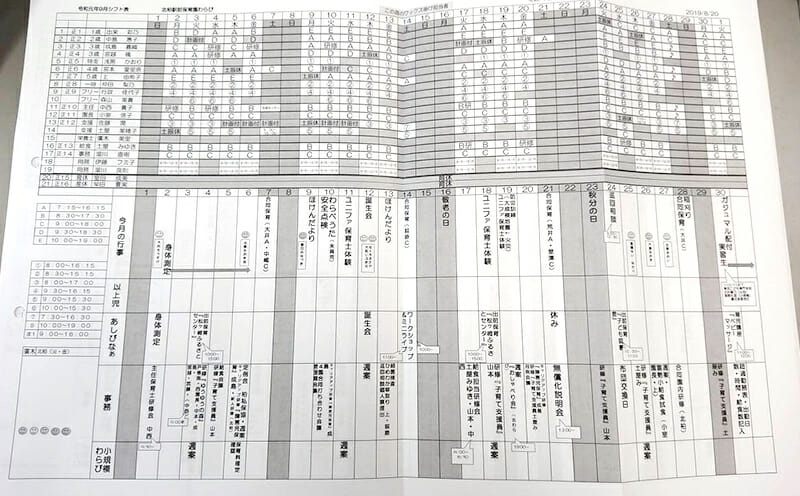
Example of a shift schedule prepared by a nursery school
Second, we have to take into consideration the workload of the daycare teachers. For example, in the case of a daycare center whose hours span from 7:00 a.m. to 8:00 p.m., we cannot ask those who finished work at 9:00 p.m. the previous day to come in at 6:45 a.m. the next day. Furthermore, early morning and night shifts are burdensome, so asking only some teachers to work these shifts would be unfair. Therefore, when creating shifts, it is necessary to count the number of times each teacher works the early morning and evening shifts. Although it is possible to work on a computer using Excel functions, few people in the childcare field have such skills, and we are still stuck in the world of manual calculations using paper.
Editorial:It's a daunting task. ......
Kobayashi:And the third time-consuming factor is that if shifts are made on paper, the shift details must be entered into the attendance system.
Editorial:When you say, "Enter shift details into the time and attendance system?"
Kobayashi:Recently, IC cards and other systems for recording attendance and dismissal times have become widespread, but in the end, overtime hours cannot be calculated without checking them against the shifts of the childcare teachers. In the end, however, it is not possible to calculate overtime hours without comparing it with the teachers' shifts. Therefore, we have added a function to "Lukumi Shift Management" to link with attendance data. This means that once a shift is completed, the data is automatically transferred to the attendance system and the overtime hours are calculated.
Our goal is not "full automation of shift creation" but "labor saving in shift creation
Editorial:We now understand the issues that you are trying to solve with "Lukumi Shift Management. Next, could you give us an idea of the operation of "Lukumi Shift Management"?
Kobayashi:First, there is a function that allows you to check whether the required number of child care teachers are assigned according to the number of "enrolled children" for that day at the daycare center. Specifically, when you enter the shift of a certain daycare teacher, it is automatically counted as the "number of daycare teachers enrolled during the hours of that shift". Then, all you have to do is enter the shifts of other childcare teachers until the required number of childcare teachers for that day is met.
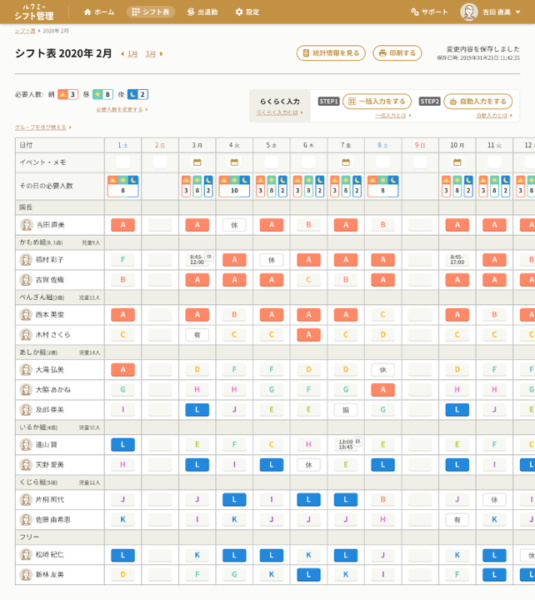
Operation screen of "Lukumi Shift Management
Editorial:So you don't have to count by hand, "Do we meet the placement criteria for this time of day?" ......
Kobayashi:That is correct. Also, if you have a daycare teacher who has to leave at 2:00 p.m. on a particular day, you can immediately see on the screen that there is a shortage of daycare teachers during the hours after 2:00 p.m. on that day. Then all you have to do is enter another teacher's shift to meet the placement criteria. The number of early morning and evening shifts and the number of Saturdays worked by teachers can also be automatically counted and checked so that the burden of early morning and evening shifts is not unevenly distributed among the teachers.
Editorial:So everything that used to have to be counted manually is now automatically converted into data!
Kobayashi:While these alone are considerable labor savings, the "automatic shift list creation function" is also a key feature of "Lukumi Shift Management". The key point is that it uses the logic of "creating a new shift list by referring to past shift lists. Conventional shift creation support systems of the same type simply create shift tables at random or require the input of a vast number of configuration items. As a result, these systems were rarely used because there was too much rework to be done, and the initial setup was too cumbersome.
Editorial:That's one of the drawbacks of the traditional "automatic work shift creation system. ......
Kobayashi:Therefore, in this system, the system automatically refers to and analyzes "shift schedules created in the past based on the circumstances of the childcare teachers" to create the shift schedules. This increases accuracy and also makes initial setup much easier. We also recommend that teachers not use the auto-create function to create their own shift list from the beginning, but rather to input some of the already determined shifts, such as their vacations and requests, and then automatically create the shifts for the vacant areas. We believe that this will minimize the amount of time and effort required for human workers to revise the created shift list later.

Mr. Kobayashi explains how to operate "Lukumi Shift Management.
Editorial:Does this "automatic shift creation function" become more accurate the more you use it?
Kobayashi:The accuracy of the system will be improved through future verification. However, it is currently possible to create new shifts based on statistical calculations of past teacher shift input and recognition of "this is the most frequently used shift by this teacher". The goal of "Lukumi Shift Management" is not to suddenly reduce shift creation time to zero, but to first make it possible to complete a task that used to take 10 hours in the past in one or two hours.
Editorial:Thank you very much. By the way, has "Lucumi Shift Management" been tested in daycare centers?
Kobayashi:We plan to start the demonstration test in late January 2020 and officially release the product around March 2020.We issued a press release for pre-orders on December 13, 2019, and thanks to your support, we have received a great number of inquiries. Perhaps by the time we release the product in March, we will be able to give you feedback from the daycare centers that actually used the product in the demonstration test.
<After the interview
Unifa Corporation is promoting "Smart Nursery School," a next-generation type of nursery school that utilizes the latest technologies such as AI to ensure child safety and parental peace of mind while reducing the workload of childcare operations. It has been a year since we last covered "Lukumi Noon Sleep Check," and we realized that the various pieces to realize the philosophy advocated by the company, including "Lukumi Shift Management," "Lukumi Photo," "Lukumi Thermometer," and "Kidsly," are now coming together. The company's use of IT devices to improve efficiency seems to be the right direction to take, as it will give the teachers more time to focus on the children they are supposed to be caring for. The company's focus on "shift creation," a task that is difficult to see from the outside but is extremely important for changing a daycare center, will have a great impact on the future of daycare center operations.
Official website of "Lukumi Shift Management
https://lookmee.jp/shift/

